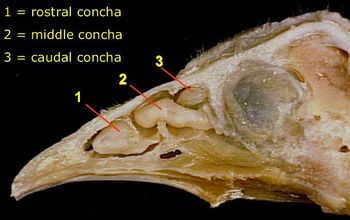Difference between revisions of "Avian Respiration - Anatomy & Physiology"
Jump to navigation
Jump to search
| Line 17: | Line 17: | ||
*The nostrils of the bird, which lead into the nasal cavity, may have a flap of horn to protect them, known as the ''Operculum''. | *The nostrils of the bird, which lead into the nasal cavity, may have a flap of horn to protect them, known as the ''Operculum''. | ||
| − | *The Oral Cavity and the Nasal Cavity of the bird are interconnecting via a slit in the hard palate called the ''Choana''. | + | *The Oral Cavity and the Nasal Cavity of the bird are interconnecting via a slit in the hard palate called the ''Choana''. Birds lack a soft palate. |
[[Image:Avianheadsaggitalsection.jpg|right|thumb|350px|©Nottingham 2008 ''Saggital Section of an Avian skull showing the conchae.]] | [[Image:Avianheadsaggitalsection.jpg|right|thumb|350px|©Nottingham 2008 ''Saggital Section of an Avian skull showing the conchae.]] | ||
*There are Rostral, Middle and Caudal Conchae arising from the lateral wall, filling part of the nasal cavity. | *There are Rostral, Middle and Caudal Conchae arising from the lateral wall, filling part of the nasal cavity. | ||
| − | **Rostral Conchae - lined with Stratified Squamous Epithelium | + | **Rostral Conchae - Vestibular Region - lined with Stratified Squamous Epithelium |
| − | **Middle Conchae - lined with [[Respiratory Epithelium - Anatomy & Physiology|Respiratory Epithelium]]. | + | **Middle Conchae - Respiratory Region - lined with [[Respiratory Epithelium - Anatomy & Physiology|Respiratory Epithelium]]. |
| − | * | + | **Caudal Conchae - Olfactory Region - lined with olfactory epithelium. |
| + | *The '''Infraorbital Sinus''' is a triangular cavity under the skin, rostroventral to the eye. | ||
| + | *Some marine birds have a ''Salt Gland'' (nasal gland) which excretes sodium. | ||
| + | * | ||
Birds vocalise using a [[Syrinx - Anatomy & Physiology|syrinx]]. | Birds vocalise using a [[Syrinx - Anatomy & Physiology|syrinx]]. | ||
Revision as of 14:51, 13 August 2008
|
|
Introduction
The avian respiratory system contains some fundamental changes to the mammalian system.
Avian Nasopharynx and Oropharynx
- The nostrils of the bird, which lead into the nasal cavity, may have a flap of horn to protect them, known as the Operculum.
- The Oral Cavity and the Nasal Cavity of the bird are interconnecting via a slit in the hard palate called the Choana. Birds lack a soft palate.
- There are Rostral, Middle and Caudal Conchae arising from the lateral wall, filling part of the nasal cavity.
- Rostral Conchae - Vestibular Region - lined with Stratified Squamous Epithelium
- Middle Conchae - Respiratory Region - lined with Respiratory Epithelium.
- Caudal Conchae - Olfactory Region - lined with olfactory epithelium.
- The Infraorbital Sinus is a triangular cavity under the skin, rostroventral to the eye.
- Some marine birds have a Salt Gland (nasal gland) which excretes sodium.
Birds vocalise using a syrinx.
Air Sacs
Links
References
- Dyce, K.M., Sack, W.O. and Wensing, C.J.G. (2002) Textbook of Veterinary Anatomy. 3rd ed. Philadelphia: Saunders.
